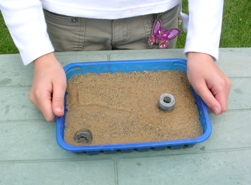A sample activity:

Quake shake – will my home collapse?
When an earthquake strikes: investigate why some buildings survive and others do not.
Set up the demonstration out of sight of the class. Place a flat piece of wood in one end of a tray and then fill the whole tray evenly with sand, so that the wood is hidden. Soak the sand thoroughly with water, then pour off the surplus water. Place two heavy objects, of identical shape and mass, representing buildings, gently on the sand at each end of the tray.
Explain that when earthquakes occur, the ground shakes violently. The model represents two buildings standing on wet sandy ground. Ask the pupils to say what they think they will see when the tray is shaken from side to side. Then shake the tray repeatedly whilst the tray is resting on a table.
After a few shakes, the sand can be seen to liquefy, and water rises to the surface. One “building” either topples over, or sinks into the sand, while the other one stays upright and does not sink. Ask the pupils to explain why they think this might be. They usually offer many ideas for what they have seen, but they seldom think that the teacher has done anything so underhand as to hide a solid object under the sand! The shaking reduces the load bearing strength of the sand, as the water forces the grains apart so that the ‘building’ without a solid support underneath falls over or sinks. This happened when Mexico City, which is built on an old lake bed, was hit by an earthquake and many buildings with poor foundations collapsed. An earthquake of the same magnitude will cause far less damage to a building built on rock.
Age range of pupils: 7 – 18 years
Time needed to complete activity: 5 minutes
Pupil learning outcomes: Pupils can:
- demonstrate how the shaking of damp sand, as if by an earthquake, reduces its strength
- explain how providing a foundation increases the strength of shaken sand, allowing it to bear loads. The foundation does not increase the strength of the shaken sand. The piece of wood provides a raft-type foundation which allows the building to ‘float’.
Context: The activity could form part of a lesson about earthquakes and their effects. It could also form part of the preparation for the best way people should respond to an earthquake in earthquake-prone areas.
Following up the activity: Try a websearch for real data.
Underlying principles:
• the slow movement of the Earth’s plates causes stress to build up in the rocks underground.
• eventually the rocks break (brittle failure) at a fault, and the rocks spring back (elastically) causing shock waves.
• two forms of shock waves are produced, longitudinal (primary, P-) waves and transverse (secondary, S-) waves.
• these waves reach the surface and cause surface waves – undulations of the Earth’s surface.
• the waves cause solid rocks to move, but when they hit waterlogged sand, the sand can lose cohesion and ‘liquify’ causing heavy masses (eg. buildings) to sink, fall over or collapse.
• people are hurt or killed by the collapsing buildings, falling broken glass or subsequent fires.
• the safest place during an earthquake is usually out in the open, away from buildings that might collapse.
Thinking skill development:
• the contrast between one ‘building’ sinking and the other not causes cognitive conflict (mental challenge)
• further discussion about what we should do when an earthquake hits causes bridging (application) of the ideas seen into potentially real contexts
(c) Earthlearningidea team. Contact the Earthlearningidea team at:
[email protected]
Useful links:
The US Geological Survey ‘Earthquakes for kids’ site -
www.earthquake.usgs.gov/learning/kids.php
Guide to selected sites for earthquake education -
www.mceer.buffalo.edu/infoservice/Reference_Services/earthquakeEducation.asp